In the digital age, landscaping website design is the cornerstone of any successful business, and landscaping businesses looking to grow are no different.
A compelling landscape company website showcases your work and specialties and helps you remain competitive, capture the local market, and build customer trust.
This guide provides a comprehensive roadmap to creating successful landscaping websites. We’ve covered you from initial considerations, such as budget and tech features, to preparation basics, like competitor research and media assets.
We delve into planning your website’s pages, developing engaging content, and implementing SEO strategies. This guide on website design for landscapers also offers tips to enhance your website’s user experience, like using garden photography and ensuring mobile-friendliness.
Why Landscaping Website Design Is Essential for Your Business?
A website serves as a platform for potential customers to make enquiries about your services, helping you generate leads.
In the modern world, people expect a business to have a website. It’s a sign of professionalism and credibility.
A website allows you to reach a wider audience and expand your customer base. Landscaping websites also allows you to retain your customer base by providing them with an account where they can manage their services.
Your website is the perfect place to showcase your previous work and highlight your specialties. Your portfolio page of commercial landscaping projects helps instill confidence in your services to your visitors.
Your prospects also needs to know how you differ from your competitors. Landscaping website is a good place to convince because they’ll want to directly hear from you first.
To stay competitive in the landscaping industry, having a well-designed and informative website is key.
It helps you capture a greater chunk of market share then your competitors. Of course the success of a landscaping website depends on how you are acquiring traffic and getting leads.
With proper SEO practices, your website can help you capture your local market by appearing in local search results.
Displaying your business and insurance credentials on your website can help build trust with potential customers.
Customers might also visit your website to see your contact details, service hours, special announcements, judge your reputation or to see your landscaping service package and pricing.
Your website serves as the foundation of your digital marketing efforts. It’s where you’ll direct traffic from social media, email marketing, and more.
If you’re in the landscaping business and don’t have a website yet, it’s high time you considered getting one.
Key Considerations for Building a Successful Landscape Company Website
Several options exist, from marketing agencies to DIY website builders. Experts from the Maplescape marketing team suggest looking at the lawn care web design options that fit your budget, time, and business plans.
If you are in the market for building a lawn care website design for your lawn and garden business, we’ll briefly state the pros and cons of today’s most prominent options.
| Options for building your landscaping website | Cost | Your involvement | Expansion | Pros |
|---|---|---|---|---|
| Landscaping web design company | Medium to high | Low | Scalable | A good agency can leverage their experience and help you with SEO and feature-rich websites. |
| Freelancers | Medium | High | Limited | In-house, the team can help you with continuous iterations, improvement and expansion. |
| In House | High | Medium | Highly scalable | In-house, the team can help you with continuous iterations, improvement and expansion. |
| Templated website builders e.g. WordPress, Shopify | Low | High | Limited | Templated website builders, e.g. WordPress, Shopify |
| DIY Website Building | Lowest | High | Very limited | Templated website builders, e.g. WordPress, Shopify |
The best choice for your landscaping website design depends on your specific needs, budget, and the time you can dedicate to this project. It’s essential to weigh these pros and cons before making a decision.
If you are starting a landscaping business, it is better to hire a freelancer who can use a website builder to quickly launch your landscape company website within your budget while still using best practices so you can scale your marketing later.
If your main goal in building landscaping websites is to sell products or digitize your offline shop, getting an e-commerce website could be expensive.
For small businesses, you can use Shopify (a DIY e-commerce website) or build a website with WordPress and WooCommerce for flexible website design for landscapers.
If you have no prior knowledge of websites, SEO, or graphic design, you should go with a landscaping web design company to build your lawn care website. You’ll have to research and train yourself, which can take around 6 months from start to finish.
Costs
As mentioned above, what you decide will depend on how you are getting your landscaping company website created and the lawn care web design approach you choose.
The DIY costs for building and lawn care website design are low—as low as $100 for a year (not including the hours you’ve spent on them).
On the other hand, costs for a custom landscaping website design with all pages, a running blog section, and regular maintenance for 6 months will set you back $3000 easily.
It all depends on who is creating your website. An experienced developer with knowledge of the landscaping industry can help you create a landscape company website that is both functional and performs better (brings you calls).
Here are some of the approximate costs for you. Know that there are always alternatives that might cost you less.
The only trick is to use things that work out for you.
If they are free or cost you, you should be able to guess some returns on your investment.
| Item | Approximate cost range |
|---|---|
| Domain – 1 year | $10 – $100 |
| Hosting – 1 year with fast enough performance | $200 |
| Content – 10 pages, 500 words average per page | $0.5 per word, $2500 |
| DIY website builders (Theme, business hosting) – 1 year ($100 per month) | $1000 |
| WordPress (Free), Plugins for extended functionality – 1 year | $500 |
| Graphic designs for media assets – 1 year | $2000 |
| Website maintenance costs – 1 year | $1000 |
| Agency for basic website creation and maintenance – 1 year | $5000 |
| Agency for custom websites (the whole shbang) | $10,000 – $15,000 |
| Freelancer for creation and maintenance – 1 year | $3000 |
Preparing for Your New Landscaping Website Design Project
Competitor research
Check out your competitor’s landscaping web design. Get a sense of their organic traffic (you can use similar websites for estimates). A high-converting website will have higher traffic and give you a fantastic experience.
The purpose of competitor research is to find inspiration from other landscaping websites and establish a benchmark for the minimum action items needed to outcompete them.
Remember to look at websites that are not just your close competitors but also indirect business websites that serve the same audience as you do, especially those showcasing effective website design for landscapers.
Some expert tips to select competitors:
- Curate the websites of the most prominent players in the landscaping industry (Brightview, The Ground Guys, Davey Tree Experts, etc). Also, look at some international players.
- Look at your local competing websites and service providers.
- Do not limit your research to your direct competitors. Instead, look at manufacturers’ websites, nursery centers’ websites, and landscaping blogs.




What to look at:
- Check their website traffic with similarweb.
- Their offerings and the page structure. How are these services presented and described? Check if they have specific local pages.
- Look at their website layout, color scheme, and visual appeal. Is it modern and user-friendly? Does it reflect the brand’s identity?
- Look at the imagery they’re using on their pages.
- Look at their blog section and topics.
- Notice the information they’re putting out and look for social proof (testimonials, reviews and ratings, case studies, etc).
- Call to action: Notice what they ask the visitor to do. Do you feel compelled to push a button or give your details? Is it easy for a potential customer to contact them or request a quote?
Choose a domain
Choosing a good domain is paramount because this is the word your prospects would remember or feel compelled to visit when your lawn care website or company is mentioned.
Your domain name should reflect your business name or the brand you want to build. In lawn care web design, it should be unique, memorable, and easy to pronounce.
While keeping it short and straightforward, think long-term.
Your domain name should capture the essence of your company’s values and industry and, in terms of lawn care website design, be etched in people’s long-term memories.
The best practice is to use your company name, but you can also do business as a brand with a different name.
Take the help of AI (ChatGPT), or free domain name generator websites to get new ideas.

Create media assets
Now that you’ve looked at your competitors and chosen a domain, you need to get some media assets created.
You need a logo (company logo), favicon, hero image, animations/video clips, images for website sections, and icon packs for an essential landscaping website design launch.
Ensure the images are of higher resolution to make your website look high quality.
Do not use AI-created images for general website imagery—they look unnatural and do not appeal to emotions. However, you can easily use AI to create animations, icon packs, and logos for your landscape company website.
Note that these images will be used at prominent places and to complement text on your landscaping websites, so hold off on buying images until you’re sure they will be used.
Most landscapers use a trick to save money on buying images: document their projects.
With mobile devices or cameras, it is easy to do before-and-after photos. These can then be edited and used on your website imagery as part of effective website design for landscapers.
Once you have essential media assets, you can start thinking about website layout, structure, visual elements and typography.
Website foundations
Your competitor research should help you get inspired and think about how your lawn care website will look.
While thinking about layout and stuff, you also need to think strategically. Keeping business growth in mind, decide how the following should look and what they should contain in your lawn care web design.
- Header – navigation and information
- Lead capture form design
- Colour scheme
- Typography, including fonts, sizes, spacing
- Footer
- Overall page structure
Plan for website pages
As you think about the overall design, you also need to plan for the initial set of pages in your lawn care website design.
The pages you need to create on your landscaping website will depend on the type of services you provide and the industries you cater to.
Apart from these, you will need to create some general pages.
The general pages that you need to create once and forget:
- Privacy policy
- Terms and conditions
- Refunds and shipping information
- Company legal information
These pages can easily be created with online generators but should be vetted by someone from legal.

Another type of page you need to look at:
- Landing pages
- Products
- Services (commercial, residential)
- Locations
- Industries/markets (sports, retail, parks, government, etc)
- Why/About page
- PPC landing pages (if you plan to run ads, you need a CRO page to get maximum conversions)
- Pricing page
- Contact us
- Portfolio page
- Blog section (for case studies, articles, news, press releases, etc)
- Careers

Nailing the landscaper’s website navigation
Best practice says visitors should be able to access every vital page in your website in just three clicks from the page they are on.
You should choose a header navigation structure so your target audience can view the desired service.
Your visitors should also be able to learn about you, and if they are curious, they should be able to explore what you have to offer with a navbar.
Keeping the header minimal with extended navigation on interaction is an industry-leading practice. The best businesses in the landscaping industry follow this practice.
Another trick is to use multiple headers. The secondary headers should be used for promos, contact information, social icons, search bars, announcements and logins.

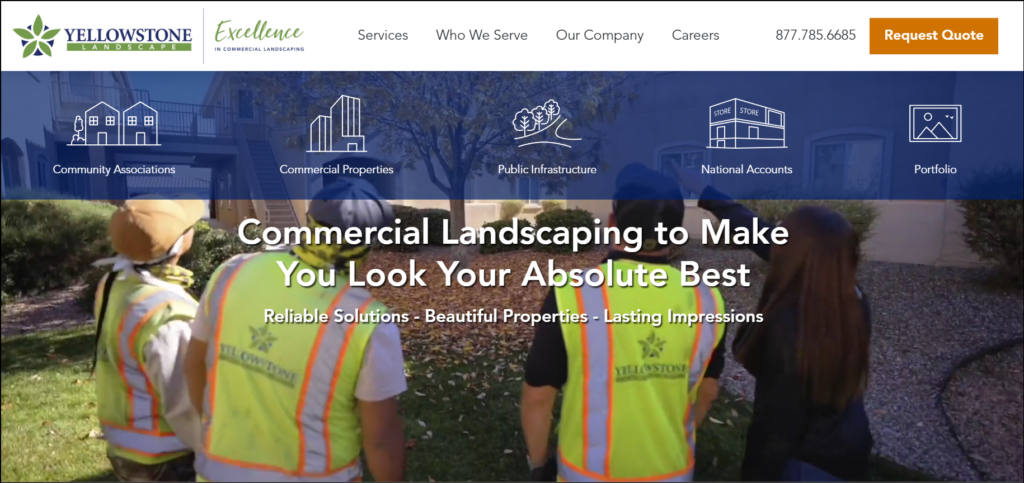


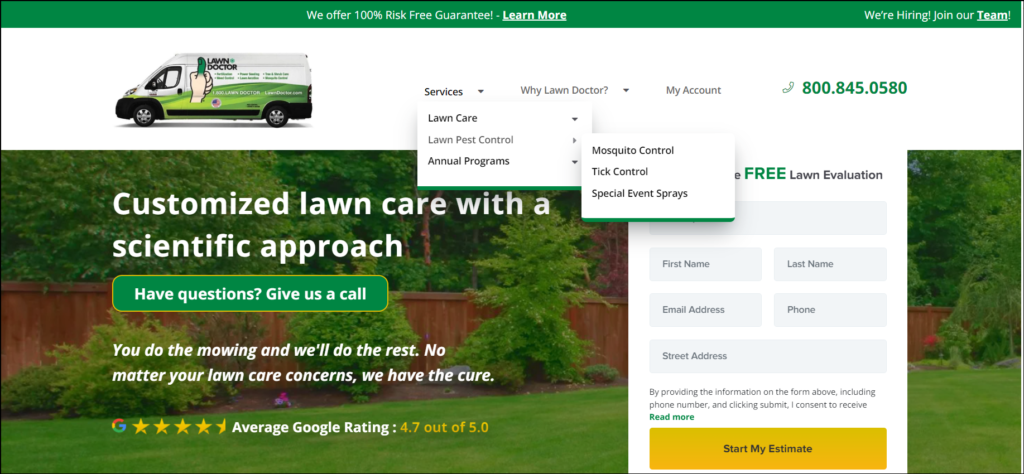

Writing content that gets you landscaping leads
The content on your website (website page copy) is one of the most essential ways to generate leads.
Copy appeals to people’s emotions and gets them to trust you.
Even if you can bring people to your website without excellent content, no one will trust you enough to give you their personal information or fill out a form.
Even if there is a need for a service, lousy website content drives people away.
Your content must be engaging enough to get people thinking about you and contacting you through your landscaping website.
You might need a copywriter with experience in writing content that converts. They will help you with a landing page framework and set you up for success.

Expert tip: Make sure to look at the results of a copy rather than just looking at a writer’s portfolio.
Since copy is present at all prominent places on your website, iterate over time to fixate on the piece that works best for you.
Also, always get meta title and meta description written with your copy. It helps with SEO.
Designing a landscaping website
If you use a landscaping website template, landscaping website design and development will go hand in hand.
No-code website builders help you to design a landscaping website in no time.
Ensure you follow the best practices to complement your design with the website copy and imagery.
If you choose a custom website build, the designer will share the Figma/Miro/inVision files to hear your thoughts.
Make sure you nail down the design to make it highly relevant to your target audience. Your landscaping website design should complement every part of your website.
Keeping accessibility in mind (primarily if you serve elder communities for their landscaping service needs), plan your web design so that it’s easier for people to find out more about you, reach you, and navigate your website.

Thinking about your target audience in this process will help you make your website ROI-driven.
A good website for customers will help them easily read the information, call you, ask queries, and trust you with their projects.
That means no tripping colors, small fonts, deceptive designs, and a family-friendly tone of voice.
While your inner voice will motivate you to paint everything green, you should be equally motivated to experiment and stand out.
Getting your website developed
Now that you’ve got the media assets, content, and design done right, the next step includes implementing your vision on a web address.
You’ll need a place to store all of that text, images and website code on the cloud called hosting.
Whenever someone types in your domain/homepage in Safari/Chrome or clicks on your website link, your hosting will serve all that beautiful content to your visitor.
Hosting is necessary because your personal computer cannot be turned on 24/7 (that’s expensive and inefficient), and you cannot use personal cloud storage as hosting (since it is not optimized for serving web content).
If you are a startup, do not invest much money in hosting.
While good hosting will help your website speed (a good thing), you do not need to be locked in for a year if you do not expect millions of visitors that year.
It is imperative, though, that you get an average one since bad hosting will drive people away. Your website will load so slowly that no one will wait that long.
Once you have your hosting, hire a developer to code your lawn care website design.
If you use a web builder, everything you design will be developed simultaneously, and you can publish your pages immediately.
While you get the development of your lawn care website design, make sure you get the following right:
- Your designs should look exactly like you envisioned them in your design files.
- Functionality should be complete. No element should feel like it’s clickable when it’s not.
- Reduce the friction points to get people to sign up or call you.
- Sense check on the copy, design and formatting so that every prominent element looks top-notch.
- Make sure that your website works perfectly on mobile devices.

SEO for landscaping websites
SEO for a landscaping website done right = organic traffic from Google & Bing = more landscaping leads
When you’re building a website, it is essential to look at SEO from the beginning.
The outcome of having SEO built in while website development is that you appear in the search results when people type in their queries related to landscaping on Google or other search engines like Bing or DuckDuckGo.

SEO helps Google and Bing better understand your website and your business. With a better understanding, search engines can rank you among your peers based on numerous factors.
Getting your website on the first page of Google doesn’t generally happen overnight (unless you’re doing some extraordinary PR). Having the right foundations helps you set yourself up for success in the future.
Your SEO will help you with the following things while you prepare for your landscaping website launch:
- Research landscaping SEO keywords that you should rank for.
- Suggest keyword placements for your landing pages and blog pages.
- Set up Google search console, Bing Webmaster, and Google Analytics to track and report on performance.
- Set up a Google My Business profile for you to appear on local searches.
- Perform on-page and tech SEO as per best practices.
- Register your business at directories frequently visited by people searching for your services.
- Help you partner with relevant websites to help you reach a wider audience.

Setting up tracking and analytics
You cannot manage what you can’t measure
Peter drucker
Now that you have your website, it is essential to measure its performance. You need to see how many visitors visit it and how many engage actively to generate leads.
This is important for measuring ROI and improving what could help your visitors stay on your website and buy your services and products.
There are several free (and freemium) tools for you to use to do this. Some of them are:
- PostHog
- Google Analytics
- Microsoft clarity
- Hotjar
- Smartlook
Some tools, like PostHog, Clarity, and Hotjar, allow you to replay session recordings and visitors to visit your website and engage with the content.
You need to think about website maintenance too
You need to think about continuously maintaining your landscaping website. Here are 4 prominent reasons why:
- A good SEO strategy to increase website traffic and landscaping leads would require you to iterate over design and content to rank it higher on search engines. It would also require you to publish more high-quality content regularly to help solve your audience’s problems. It’s how they notice you are someone who can help with your experience and expertise.
- You’ll need to refresh your pages to stay relevant and at the top of your competitors.
- You will need website maintenance to address any security issues that might harm your online reputation and to improve the experience for your prospects and current customers.
- This is for posting announcements, keeping your customers and landscaping services prospects up to date, and introducing new features for your visitors.
If you choose a website builder, the most necessary parts will be easy, and with some training, your admin should be able to do most of them.
Your go-to agency should help set up SOPs for essential maintenance anyway.
If you plan to build a customized website, you’ll need someone on a retainer to continually test, analyze, and improve your website over time to help you grow your business and reach your online sales goals.
Features of the best-performing landscaping websites
We’ve analyzed some of the best landscaping websites, and here are our key observations:
The best-performing landscaping websites have:
- Image gallery of projects along with every case study.
- Online shops let customers purchase packages and products.
- Awesome landscaping websites make it easy for customers to reach you. They offer phone numbers, contact forms, office addresses, social links, email, quote request forms, and a live chat widget.
- Differentiated pages exist for every product (Services, industries, helpful article content, about the company, and more).
- Process explanation on how the company operates for complex projects.
- Landscaping business videos with client testimonies and company project success stories.
- Social proof – customer testimonials, number of projects, reviews, ratings.
- Documented projects and used those media assets on Portfolio pages, blog sections, website page images, and Google My Business updates.
- Customer referral or a landscaping affiliate program.
- They build trust by mentioning contractor licenses and certificates, landscaping insurance numbers, courses and training taken by their team, diplomas, and schooling.
- Pricing information: The industry leaders do not waste time on people. People will choose to buy from companies with their pricing on the front. Others that do not have the pricing upfront are generally left out in the prospecting stage of potential buyers.
- Great landscaping websites have phenomenal site speed and a great user experience.
Blog section: Does every landscaping website need one?
Depends on your goals.
If your goal is to have an online presence and a place for people to get your contact information and some information about you, then a blog section is not required.
Publishing blogs regularly is a good idea if you want to increase visitors and landscaping leads with digital marketing.
Why?
When you publish blogs – no fluff, consistent pieces that are problem-focused to help others find solutions– search engines analyze them and help your website blog page appear on search results when your target audience searches for related topics.
It helps the person to find the information they’re looking for. In the process, they also get to know about you.
This brings your brand much-needed visibility. A person who has never heard about you knows you have the solution to their problem.
If that person is motivated enough, they’ll ask for more of your help with their problems, and you’ve got a customer (well, a landscaping lead first and a customer only if you can qualify and convert them).
What should you post?
Well, that’s a post for another blog post on Maplescapes!
We’ll post some definitive topics you should cover for your landscaping website next!
Stay tuned! (You can contact us or let us know in the comments that you need those blog topics NOW!)
Questions that landscapers ask us frequently on website creation
Can a pre-built website with a DIY website builder bring us leads?
Yes. Templated websites help you go to market faster with considerably fewer resources. You’ll still need excellent content and some tweaks to differentiate and adapt the website to your brand image, but it’s entirely possible.
Why should we focus on a website that works on mobile?
Your customers spend a lot of time on their mobile phones searching for information. You will lose trust and credibility if your website doesn’t look good on mobiles. All yof our landscaping website pages need to be mobile responsive.
WordPress, Wix, and Squarespace are bad for landscaping websites. What do you think?
Choosing WordPress over a customer-built website is not bad. Every platform and method has pros and cons. It depends on your goals. If what you’re trying to achieve is possible and makes business sense with WordPress, you should go for it for your landscaping website.
Is landscaping SEO fake for websites?
SEO is not fake. Good SEOs help you rank your website better on search engines. Ranking better means higher visibility on search engines for your core terms, which means more traffic. More traffic means more leads for your business.
SEO helps search engines better understand your high-quality content and website so they can do their work and rank you among your competitors for those queries millions of people type on the search bar.
That being said, all those guaranteeing 1st-page rankings are red flags.
SEO could be a good lead channel for you in some time, provided you do not entirely depend on SEO to bring you leads.
Websites seem like a lot of work. Do they even pay off?
A landscaping website has multiple benefits. Getting a good ROI from a website depends on the website quality, user experience, and your brand reputation. So, landscaping pays off, provided you create one by keeping your audience in mind.
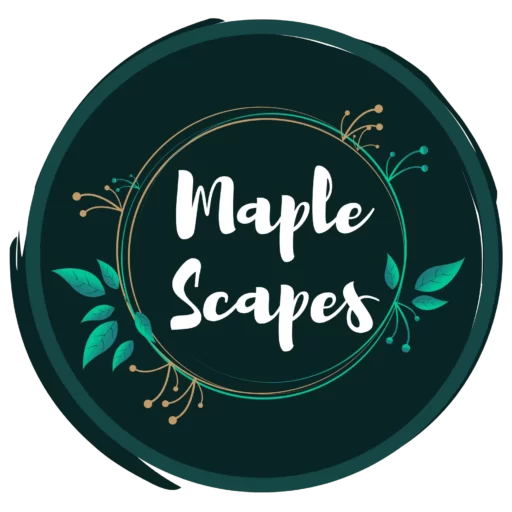

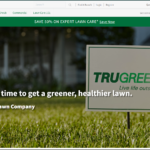

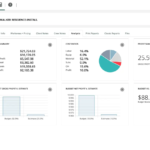

helpful for my new website. Cheers mate
I am trying to get my website created for my tree care business. but after reading this, it looks like I am better off using a drag-and-drop builder
Lawn mowing is a key part of keeping a yard looking neat and healthy. This article highlights the importance of proper mowing techniques for long-term lawn care. How often do you recommend mowing for optimal grass health?